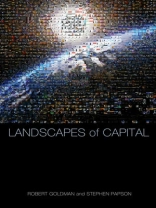Every era has its dominant representations. Just as landscape painters of previous centuries captured and expressed new modes of perceiving history, corporate advertisers now devise the imagined landscapes of global capitalism. Advertising functions as an omnipresent discursive form, publicly assembling and circulating the predominant tropes of our era. This project is based on the premise that corporate advertising’s landscapes help shape our epoch’s imaginative conceptualizations of the spatial relations, the temporal flows, and the cultural geographies that correspond to the emergence of a high-tech global economy.
In Landscapes of Capital Robert Goldman and Steven Papson examine how corporate television ads from the last fifteen years have organized predominant images, tropes and narrative representations of a world in transition. The volume takes particular interest in how relations of space, time, speed, capital, technology and globalization are narratively represented in advertising. Goldman and Papson skillfully demonstrate how Capital represents itself at a moment of critical historical transition Ð the passage into high-tech globalization and the crises associated with it. They argue that corporate ads can be read to reveal how Capital represents itself and the world that is being wrought Ð in terms of the signifiers it prefers and the stories it tells.
Tabella dei contenuti
Detailed Table of Contents
Acknowledgements
1.Mapping the symbolic landscape of corporate capital
2. Dreamworks of the ‘new economy’
3. Landscapes of fictitious capital
4. The social relations of production in the network economy
5. Landscapes of speed: blurred visions of capital
6. Deterritorialized and reterritorialized: the semiotic architecture of capital
7. The cultural geography of the corporate imaginary
8. Mapping the terrain in a sign economy
Bibliography
Circa l’autore
Robert Goldman is Professor of Sociology at Lewis & Clark College and Stephen Papson is Professor of Film and Representation at St. Lawrence University.












